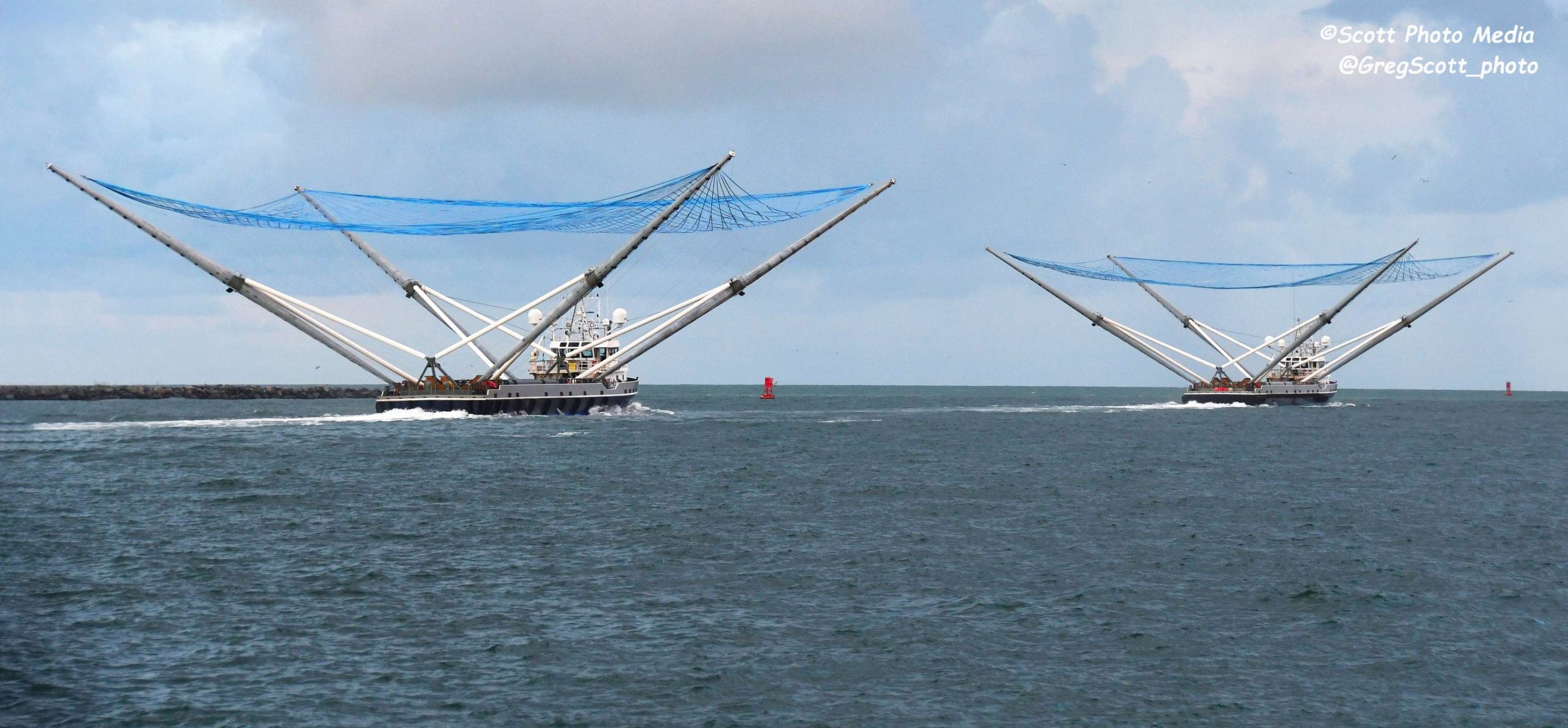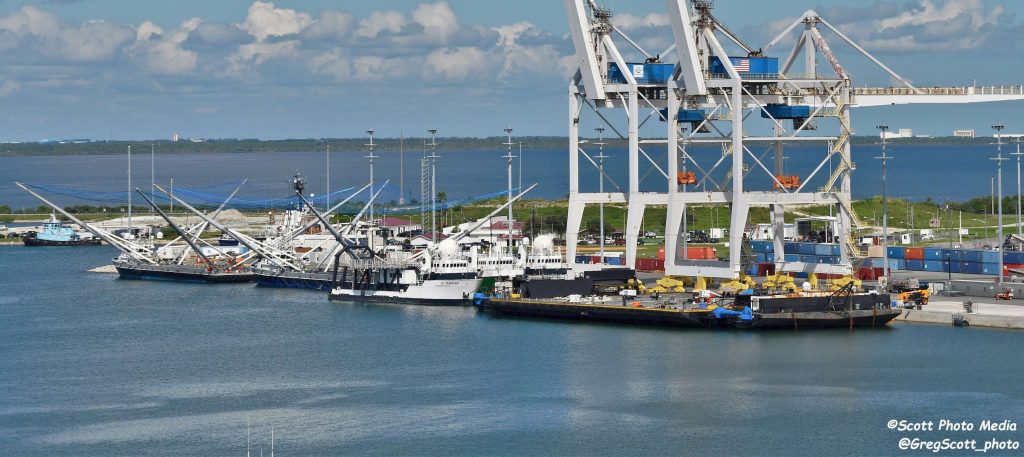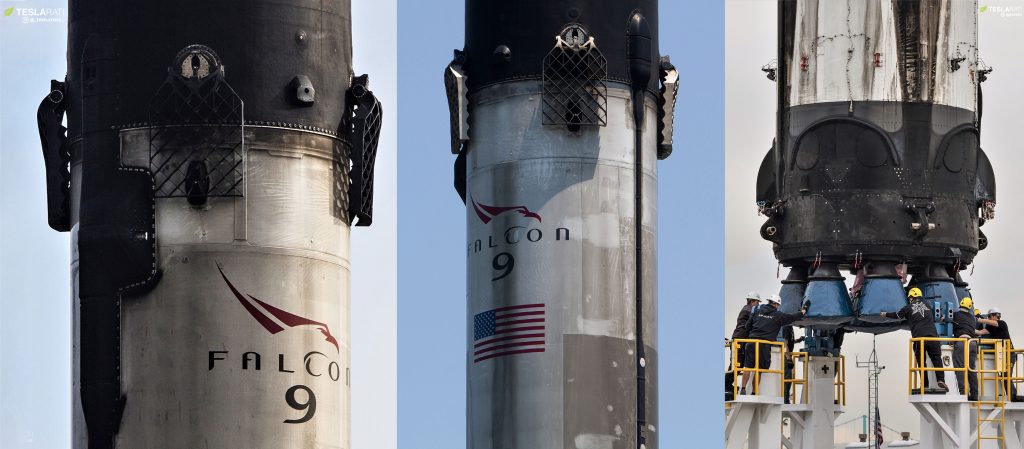

News
SpaceX’s next Falcon 9 launch set to debut twin fairing recovery ships
SpaceX’s next Falcon 9 launch – a dedicated Starlink mission scheduled no earlier than November 11th – appears to be set to debut twin fairing recovery vessels GO Ms. Chief and GO Ms. Tree, a fairing recovery milestone that will be paired with at least two more rocket reusability firsts.
Captured below on October 31st and above on November 6th, SpaceX’s twin fairing recovery ships departed Port Canaveral yesterday for cooperative sea trials, the first time both Ms. Tree and Ms. Chief left the port together. Over the last three or so months, SpaceX recovery technicians and engineers outfitted GO Ms. Chief, a new addition to the fleet and essentially the twin of Ms. Tree (formerly Mr. Steven).

By late-October, Ms. Chief’s new communications antennas, four large arms (each with two booms), a large net, and other miscellaneous hardware had been successfully installed, completing the ship’s transformation from a high-performance Fast Supply Vessel (FSV) into a Falcon fairing recovery asset. Aside from some slight tweaks and upgrades to her arms and rigging systems, Ms. Chief – as seen above – is now almost indistinguishable from Ms. Tree. This is no coincidence: Ms. Chief and Ms. Tree are essentially two parts of a single recovery mechanism, each meant to catch one of Falcon 9’s (or Falcon Heavy’s) payload fairing halves after launches.
As it turns out, SpaceX already has put the first Falcon 9 payload fairing reuse into motion – the November 11th Starlink-1 launch will reuse a fairing that gently landed in the Atlantic Ocean after Falcon Heavy Block 5’s April 2019 launch debut. Starlink satellites have been designed to be uniquely resistant to the violent acoustic environment of launch and able to tolerate a less-than-pristine environment inside the fairing, whereas most satellites demand cleanroom-equivalent conditions. Nevertheless, if SpaceX can routinely catch both Falcon fairing halves with both ships, it would likely enable far faster payload fairing reuse and potentially open the practice up to customer launches.
Local photographer and cookie distributor Julia Bergeron observed Wednesday’s sea trials and concluded that Ms. Tree and Ms. Chief were likely performing their first cooperative dynamic positioning tests, verifying the systems that both ships will use to guide themselves (and be guided by Falcon fairings) to successful catches.
Climbing the reusability ladder
Aside from marking the first attempted Falcon fairing reuse and potentially featuring the first attempted catch of both fairing halves, SpaceX’s Starlink-1 mission will also be the first time a Falcon 9 Block 5 booster will support its fourth orbital-class launch. SpaceX has now flown four Falcon 9 boosters three times (B1046-B1049) but has yet to pass the four-flight barrier.

With internal Starlink launches, SpaceX no longer has to worry about convincing customers to accept the risk of being first for any given reusability milestone, and the company intends to use that freedom to continuously push Falcon 9 reusability as far and as quickly as it can. Starlink-1 – involving two separate flight-proven hardware ‘firsts’ and the first dual fairing recovery attempt – will kick off that new era of flexibility and is scheduled to launch no earlier than 9:55 am ET (14:55 UTC), November 11th.
Check out Teslarati’s Marketplace! We offer Tesla accessories, including for the Tesla Cybertruck and Tesla Model 3.

News
Tesla FSD v14.2.2 is getting rave reviews from drivers
So far, early testers have reported buttery-smooth drives with confident performance, even at night or on twisty roads.

Tesla Full Self-Driving (Supervised) v14.2.2 is receiving positive reviews from owners, with several drivers praising the build’s lack of hesitation during lane changes and its smoother decision-making, among others.
The update, which started rolling out on Monday, also adds features like dynamic arrival pin adjustment. So far, early testers have reported buttery-smooth drives with confident performance, even at night or on twisty roads.
Owners highlight major improvements
Longtime Tesla owner and FSD user @BLKMDL3 shared a detailed 10-hour impression of FSD v14.2.2, noting that the system exhibited “zero lane change hesitation” and “extremely refined” lane choices. He praised Mad Max mode’s performance, stellar parking in locations including ticket dispensers, and impressive canyon runs even in dark conditions.
Fellow FSD user Dan Burkland reported an hour of FSD v14.2.2’s nighttime driving with “zero hesitations” and “buttery smooth” confidence reminiscent of Robotaxi rides in areas such as Austin, Texas. Veteran FSD user Whole Mars Catalog also demonstrated voice navigation via Grok, while Tesla owner Devin Olsen completed a nearly two-hour drive with FSD v14.2.2 in heavy traffic and rain with strong performance.
Closer to unsupervised
FSD has been receiving rave reviews, even from Tesla’s competitors. Xpeng CEO He Xiaopeng, for one, offered fresh praise for FSD v14.2 after visiting Silicon Valley. Following extended test drives of Tesla vehicles running the latest FSD software, He stated that the system has made major strides, reinforcing his view that Tesla’s approach to autonomy is indeed the proper path towards autonomy.
According to He, Tesla’s FSD has evolved from a smooth Level 2 advanced driver assistance system into what he described as a “near-Level 4” experience in terms of capabilities. While acknowledging that areas of improvement are still present, the Xpeng CEO stated that FSD’s current iteration significantly surpasses last year’s capabilities. He also reiterated his belief that Tesla’s strategy of using the same autonomous software and hardware architecture across private vehicles and robotaxis is the right long-term approach, as it would allow users to bypass intermediate autonomy stages and move closer to Level 4 functionality.
News
Elon Musk’s Grok AI to be used in U.S. War Department’s bespoke AI platform
The partnership aims to provide advanced capabilities to 3 million military and civilian personnel.

The U.S. Department of War announced Monday an agreement with Elon Musk’s xAI to embed the company’s frontier artificial intelligence systems, powered by the Grok family of models, into the department’s bespoke AI platform GenAI.mil.
The partnership aims to provide advanced capabilities to 3 million military and civilian personnel, with initial deployment targeted for early 2026 at Impact Level 5 (IL5) for secure handling of Controlled Unclassified Information.
xAI Integration
As noted by the War Department’s press release, GenAI.mil, its bespoke AI platform, will gain xAI for the Government’s suite of tools, which enable real-time global insights from the X platform for “decisive information advantage.” The rollout builds on xAI’s July launch of products for U.S. government customers, including federal, state, local, and national security use cases.
“Targeted for initial deployment in early 2026, this integration will allow all military and civilian personnel to use xAI’s capabilities at Impact Level 5 (IL5), enabling the secure handling of Controlled Unclassified Information (CUI) in daily workflows. Users will also gain access to real‑time global insights from the X platform, providing War Department personnel with a decisive information advantage,” the Department of War wrote in a press release.
Strategic advantages
The deal marks another step in the Department of War’s efforts to use cutting-edge AI in its operations. xAI, for its part, highlighted that its tools can support administrative tasks at the federal, state and local levels, as well as “critical mission use cases” at the front line of military operations.
“The War Department will continue scaling an AI ecosystem built for speed, security, and decision superiority. Newly IL5-certified capabilities will empower every aspect of the Department’s workforce, turning AI into a daily operational asset. This announcement marks another milestone in America’s AI revolution, and the War Department is driving that momentum forward,” the War Department noted.
News
Tesla FSD (Supervised) v14.2.2 starts rolling out
The update focuses on smoother real-world performance, better obstacle awareness, and precise end-of-trip routing, among other improvements.

Tesla has started rolling out Full Self-Driving (Supervised) v14.2.2, bringing further refinements to its most advanced driver-assist system. The new FSD update focuses on smoother real-world performance, better obstacle awareness, and precise end-of-trip routing, among other improvements.
Key FSD v14.2.2 improvements
As noted by Not a Tesla App, FSD v14.2.2 upgrades the vision encoder neural network with higher resolution features, enhancing detection of emergency vehicles, road obstacles, and human gestures. New Arrival Options let users select preferred drop-off styles, such as Parking Lot, Street, Driveway, Parking Garage, or Curbside, with the navigation pin automatically adjusting to the user’s ideal spot for precision.
Other additions include pulling over for emergency vehicles, real-time vision-based detours for blocked roads, improved gate and debris handling, and extreme Speed Profiles for customized driving styles. Reliability gains cover fault recovery, residue alerts on the windshield, and automatic narrow-field camera washing for new 2026 Model Y units.
FSD v14.2.2 also boosts unprotected turns, lane changes, cut-ins, and school bus scenarios, among other things. Tesla also noted that users’ FSD statistics will be saved under Controls > Autopilot, which should help drivers easily view how much they are using FSD in their daily drives.
Key FSD v14.2.2 release notes
Full Self-Driving (Supervised) v14.2.2 includes:
- Upgraded the neural network vision encoder, leveraging higher resolution features to further improve scenarios like handling emergency vehicles, obstacles on the road, and human gestures.
- Added Arrival Options for you to select where FSD should park: in a Parking Lot, on the Street, in a Driveway, in a Parking Garage, or at the Curbside.
- Added handling to pull over or yield for emergency vehicles (e.g. police cars, fire trucks, ambulances).
- Added navigation and routing into the vision-based neural network for real-time handling of blocked roads and detours.
- Added additional Speed Profile to further customize driving style preference.
- Improved handling for static and dynamic gates.
- Improved offsetting for road debris (e.g. tires, tree branches, boxes).
- Improve handling of several scenarios, including unprotected turns, lane changes, vehicle cut-ins, and school buses.
- Improved FSD’s ability to manage system faults and recover smoothly from degraded operation for enhanced reliability.
- Added alerting for residue build-up on interior windshield that may impact front camera visibility. If affected, visit Service for cleaning!
- Added automatic narrow field washing to provide rapid and efficient front camera self-cleaning, and optimize aerodynamics wash at higher vehicle speed.
- Camera visibility can lead to increased attention monitoring sensitivity.
Upcoming Improvements:
- Overall smoothness and sentience.
- Parking spot selection and parking quality.








